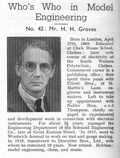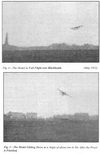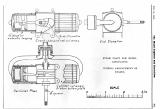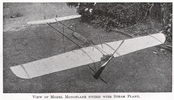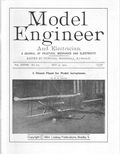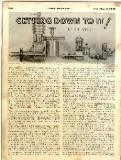HH Groves - Model Aviation Pioneer
Last update: September 2005
There must be literally hundreds of "forgotten pioneers" in the development of powerplants for models. For some, we are fortunate to have printed records available that enable us to piece together their contributions. Such is the case with Mr HH Groves (Blackheath, England). This page reflects what my modest library contains on his contributions.
HH Groves was a model engineer with a love of steam powerplants for aircraft, boats, and locomotives. In the period leading up the Great War of 1914-18, Groves held records for flash steam powered boats. He was also one of the founder members of the British Kite and Model Aeroplane Association (KMAA), formed on January 1, 1909. Also part of this organization was Mr David Stanger, famous for his intricate but practical multi cylinder four-stroke model engines. In May 1922, the KMAA was reorganized after inactivity occasioned by the 14-18 war into the Society of Model Aeronautical Engineers (SMAE) by Mr FJ Camm, taking over the records of the KMAA [1]. The SMAE continues to this day.
As reported in the Model Engineer and Electrician, circa 1912, Groves had perfected a flash-steam power plant for powered flight weighing a total of 1-1/2 lbs. The engine configuration was horizontally opposed with two single-acting cylinders . It provided flights of approximately 30 seconds, attaining 100 feet altitude using 2 oz of water vaporized by 3/4 oz of "benzoline". The issue provides grainy photos of Groves' canard pusher monoplane with a wing span of 5' 8-1/2", in flight over Blackheath [2].
Subsequently, a complete description of the engine and flash-steam boiler was published in a series of articles written by Groves. These appeared in the Model Engineer commencing with the May 22, 1913 issue (Volume 28, Issue 630), and running through to June 5 of the same year. A follow-on piece appeared in the December 4 issue gave dimensioned front and side views of the monoplane, omitting the all important plan view. Construction was stated as being of ash and bamboo with joints formed by wrapping them in silk tape that has been soaked in cement. The airframe was extensively braced with steel wire and turnbuckles--following full-size construction practice of the time [3].
Another Model Engineer article by Groves titled A Lightweight Flash Steam Plant for Model Aircraft appeared in the Model Engineer, Volume 74, Issue 1822, circa the first half of 1936. Having no access to these issues, I can offer no comment on whether this was a new design, or a revision of the earlier work.
The initial series by Groves, but excluding the monoplane two-view drawing has been collected and republished by Lindsay's Technical Books. It is interesting to note that the model depicted on the cover of the first issue is a biplane. Of this 40 page booklet, only half reprints Groves' work. The remainder comprises other articles on steam boilers gleaned from the same ME volume. These are most definitely not aimed at the aeronaut! The quality is clear, but distortion on alternate margins indicates that the original source was a bound volume, possibly the bound reprints issued by Percival Marshall Ltd many decades after the original appearance.
Remarkably, the actual engine with fragments of the airframe attached still exists and is featured in the Engine Gallery, Page 4.
Groves was an innovator and experimenter. Starting with Sparey's 5cc engine, he scaled it down to one-third of the published size. This linear reduction resulting in a 0.189cc engine. While I was busy being born, details of his experiments were published in the Model Mechanic of Feb/March, 1947--said magazine then under the editorship of Lawerence H Sparey himself.
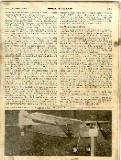 As the article describes, he next went to a half (linear) scale version, resulting in a 0.625cc engine--almost precisely the capacity of Sparey's own miniature diesel, popularly but incorrectly termed the Sparey .8cc. While compression ignition engines of this size were being made (and sold!) in France at the time, it is possible that Groves' experiments were amongst the first of their type in England.
As the article describes, he next went to a half (linear) scale version, resulting in a 0.625cc engine--almost precisely the capacity of Sparey's own miniature diesel, popularly but incorrectly termed the Sparey .8cc. While compression ignition engines of this size were being made (and sold!) in France at the time, it is possible that Groves' experiments were amongst the first of their type in England.
In the early 1950's, Groves adapted what appears to be Weaver-Ransom 1cc diesel to spin a 20" diameter balsa prop through 9:1 gear reduction. A dog-clutch appears to have been fitted, perhaps for free-wheeling after the engine cut, but then again, perhaps not--as this would result in free-wheeling the gear-train and flywheel as well. The propeller was shock-mounted to a Wakefield "streamliner" like airframe (in other words: held on by rubber bands  ). How the airframe resurfaced, intact, almost 50 years later was told by Michael Barton in the SAM 35 Yearbook #11 [4].
). How the airframe resurfaced, intact, almost 50 years later was told by Michael Barton in the SAM 35 Yearbook #11 [4].
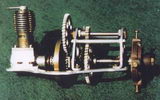 Although the current owner of the original powerplant was known, attempts to examine it proved futile. Hence a replica was constructed using the photograph shown here. This employed a Mills .75 with an improved free-wheel device incorporated into to the prop hub itself--the later being one of the two originals, still retained by rubber bands.
Although the current owner of the original powerplant was known, attempts to examine it proved futile. Hence a replica was constructed using the photograph shown here. This employed a Mills .75 with an improved free-wheel device incorporated into to the prop hub itself--the later being one of the two originals, still retained by rubber bands.
While Grove's son recalls him flying the model often, first efforts to fly it resulted merely in extended "powered glides". The required trim adjustments and general cleanliness of the engine bay suggest that it was unlikely that the aircraft had previously flown. Replacing the prop with a large, highly efficient and modern carbon fiber item intended for electric flight provided a degree of success. The full story behind this adventure is recounted in the SAM 35 yearbook Number 12 [5] by the perpetrators, Mike Beach, who restored the airframe, and none other than our own Ken Croft, responsible for the engine work.
Sadly none of my available references can shed any light on what the initials "HH" may have stood for. Web searches have yielded only references back to my own pages! Even the "Who's Who: Mr H.H.G." by the Model Engineer Editor that appeared in Volume 77 of the ME, Issue 1090, page 462 (1937) casts no light (the scan of this piece heads this page and was most kindly provided by a reader in England with an almost complete set of the Model Engineer). If anyone can document what the initials stood for, I'd be most greatful.
References:
| [1] | Camm, FJ: Model Aeroplane Handbook, George Newness Ltd, London, 1949, p13. |
| [2] | Smeed, V: Model Engineer Centenennial Collection, Volume 6: Vintage Model Aircraft, Nexus Special Interests Ltd, Kent, England 1999, p29. |
| [3] | ibid. p35. |
| [4] | Barton, M: Mystery Plane, SAM 35 Year Book Number 11, Dorking Litho Ltd, Surrey, England 2000, p47. |
| [5] | Croft, K: Mystery Plane, SAM 35 Year Book Number 12, Dorking Litho Ltd, Surrey, England 2002, p47. |
...and no, that is not a cut-and-paste error; two different articles with the same name, "Mystery Plane", actually do appear on the same page number in the two different issues of the SAM 35 yearbook!
![]()
